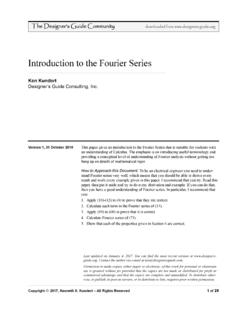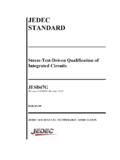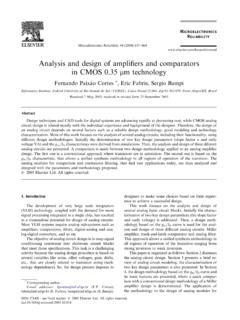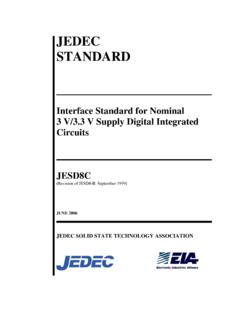Transcription of Predicting the Phase Noise and Jitter of PLL-Based ...
1 The Designer s Guide Communitydownloaded from 2002 2015, Kenneth S. Kundert All Rights Reserved1 of 52 Version 4i, 23 October 2015 Two methodologies are presented for Predicting the Phase Noise and Jitter of a PLL-Based frequency synthesizer using simulation that are both accurate and efficient. The methodologies begin by characterizing the Noise behavior of the blocks that make up the PLL using transistor-level RF simulation. For each block, the Phase Noise or Jitter is extracted and applied to a model for the entire paper was written in August 2002.
2 It was last updated on October 24, 2015. You can find the most recent version at Contact the author via e-mail at to make copies, either paper or electronic, of this work for personal or classroom use is granted without fee provided that the copies are not made or distributed for profit or commer-cial advantage and that the copies are complete and unmodified. To distribute otherwise, to pub-lish, to post on servers, or to distribute to lists, requires prior written s Guide is a registered trademark of Kenneth S.
3 Kundert. All rights the Phase Noise and Jitter of PLL-Based Frequency SynthesizersKen KundertDesigner s Guide Consulting, the Phase Noise and Jitter of PLL-Based Frequency SynthesizersIntroduction2 of 52 The Designer s Guide Introduction Synthesis Simulation Direct Simulation Fails Carlo- based Methods Noise in PLLs 52 Phase -Domain Model Stability Transfer Functions Model 113 Oscillators Phase Noise Oscillator Phase Noise Models for the Oscillators 164 Loop Filter 175 Phase Detector and Charge Pump 186 Frequency Dividers Noise .
4 To Phase Noise Model for Dividers 217 Fractional-N Synthesis 228 Jitter Metrics of Jitter 269 Synchronous Jitter Synchronous Jitter 2910 Accumulating Jitter Extracting Accumulating Jitter 3211 Jitter of a PLL 3512 Modeling a PLL with Jitter Modeling Driven Blocks Modeling Accumulating Jitter VCO Model Efficiency of the Models 3913 Simulation and Analysis 4514 Example 4615 Conclusion If You Have Questions 491 Introduction Phase -locked loops (PLLs) are used to implement a variety of timing related functions, such as frequency synthesis, clock and data recovery, and clock de-skewing.
5 Any Jitter or Phase Noise in the output of the PLL used in these applications generally degrades the performance margins of the system in which it resides and so is of great concern to the designers of such systems. Jitter and Phase Noise are different ways of referring to an undesired variation in the timing of events at the output of the PLL. They are difficult to IntroductionPredicting the Phase Noise and Jitter of PLL-Based Frequency Synthesizers3 of 52 The Designer s Guide with traditional circuit simulators because the PLL generates repetitive switch-ing events as an essential part of its operation, and the Noise performance must be eval-uated in the presence of this large-signal behavior.
6 SPICE is useless in this situation as it can only predict the Noise in circuits that have a quiescent (time-invariant) operating point. In PLLs the operating point is at best periodic, and is sometimes chaotic. Recently a new class of circuit simulators has been introduced that are capable of pre-dicting the Noise behavior about a periodic operating point [18]. Spectre RF1 is the most popular of this class of simulators and, because of the algorithms used in its imple-mentation, is likely to be the best suited for this application [1].
7 These simulators can be used to predict the Noise performance of PLLs. The ideas presented in this paper allow those simulators to be applied even to those PLLs that have chaotic operating focus of this paper is frequency synthesis. Information on Predicting the Noise and Jitter of clock and data recovery circuits can be found elsewhere [21,23]. Frequency SynthesisThe block diagram of a PLL operating as a frequency synthesizer is shown in Figure 1 [8]. It consists of a reference oscillator (OSC), a Phase /frequency detector (PFD), a charge pump (CP), a loop filter (LF), a voltage-controlled oscillator (VCO), and two frequency dividers (FDs).
8 The PLL is a feedback loop that, when in lock, forces ffb to be equal to fref. Given an input frequency fin, the frequency at the output of the PLL is(1)where M is the divide ratio of the input frequency divider, and N is the divide ratio of the feedback divider. By choosing the frequency divide ratios and the input frequency appropriately, the synthesizer generates an output signal at the desired frequency that inherits the long-term stability of the input oscillator.
9 In RF transceivers, this architec-ture is commonly used to generate the local oscillator (LO) at a programmable fre-quency that tunes the transceiver to the desired channel by adjusting the value of Direct SimulationIn many circumstances, SpectreRF can be directly applied to predict the Noise perfor-mance of a PLL. To make this possible, the PLL must at a minimum have a periodic steady state solution. This rules out systems such as bang-bang clock and data recovery circuits and fractional-N synthesizers because they behave in a chaotic way by design.
10 It 1. Spectre is a registered trademark of Cadence Design 1 The block diagram of a frequency N MfinfrefffbfoutPredicting the Phase Noise and Jitter of PLL-Based Frequency SynthesizersIntroduction4 of 52 The Designer s Guide rules out any PLL that is implemented with a Phase detector that has a dead zone. A dead zone has the effect of opening the loop and letting the Phase drift seemingly at ran-dom when the Phase of the reference and the output of the voltage-controlled oscillator (VCO) are close. This gives these PLLs a chaotic perform a Noise analysis, SpectreRF must first compute the steady-state solution of the circuit with its periodic steady state (PSS) analysis.









